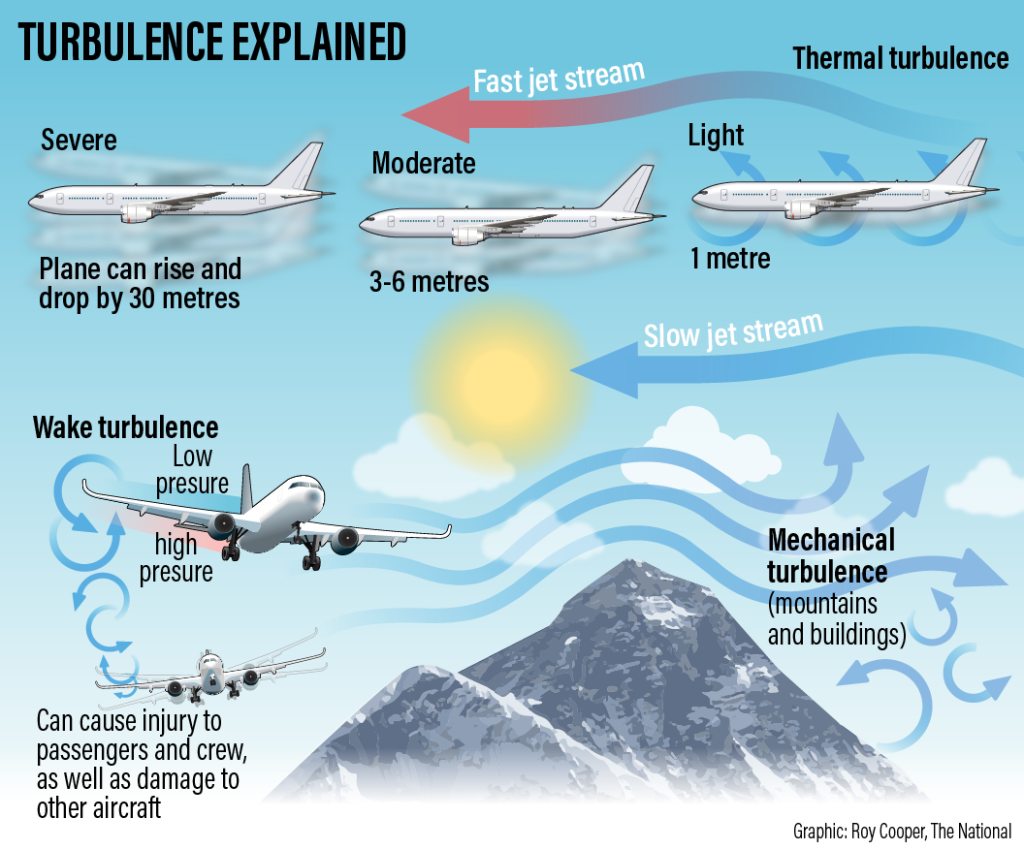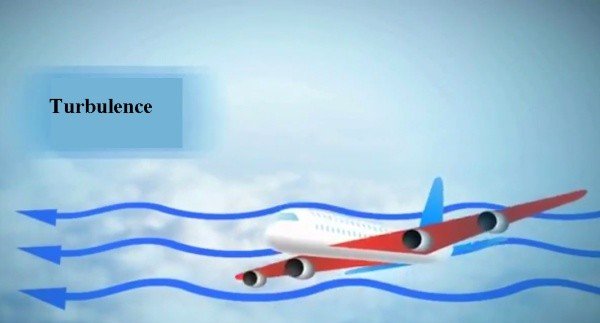- Key Takeaways
- Defining Clear Air Turbulence
- Origins and Causes
- Common Locations
- Effects on Flights
- Crew Tactics and Defences
- Real-Time Monitoring Solutions
- Handling Severe Events
- Investigating Incidents
- Further Insights and Reading
- Summary
- Frequently Asked Questions
- What is clear air turbulence (CAT)?
- Why does clear air turbulence happen?
- Where is clear air turbulence most common?
- How do flight crews handle clear air turbulence?
- What can passengers do to stay safe during clear air turbulence?
- Are there any technologies that help predict clear air turbulence?
- How are incidents of severe clear air turbulence investigated?
Every year, clear air turbulence, caused by sudden changes in wind speed, is responsible for more in-flight injuries, including serious injury, to airplane passengers than any other form of weather disturbance, challenging even the most experienced pilot. Yet, it remains one of the least understood phenomena among passengers, cabin crew, and flight crew on an airplane, including the pilot. This invisible threat occurs with little warning in the atmosphere, making it a silent concern for the airplane’s pilot and flight crew in the skies. Understanding where in the atmosphere, specifically the troposphere, and why clear air turbulence happens, along with practical steps for a pilot and airplane to mitigate its effects, is crucial for both seasoned travellers and aviation enthusiasts alike. Our guide dives into the science behind this atmospheric phenomenon, focusing on the troposphere where airplanes fly, and offers actionable advice, including cabin crew procedures, to ensure your next flight is as smooth as possible.

Key Takeaways
- Clear Air Turbulence (CAT) is an aviation phenomenon that occurs without visible warning, making it crucial for passengers to always heed the seatbelt sign even when the sky appears clear.
- Understanding the origins and common causes of CAT, such as jet streams and mountain waves, can help flyers grasp why certain flight paths are more prone to turbulence.
- Familiarising oneself with the common locations for CAT, including areas near mountain ranges and over oceans, allows passengers to mentally prepare for possible turbulence during flights over these regions.
- The implementation of crew tactics and defences, alongside real-time monitoring solutions, significantly reduces the risks associated with CAT, showcasing the aviation industry’s commitment to safety.
- In the event of severe turbulence, knowing how to properly brace oneself can minimise injuries, underscoring the importance of paying attention to safety briefings.
- The ongoing investigation into CAT incidents and the development of advanced detection technology promise further improvements in predicting and navigating through clear air turbulence, enhancing passenger comfort and flight safety.
Defining Clear Air Turbulence
CAT Phenomenon
Clear Air Turbulence (CAT), influenced by gravity waves, circulation, and terrain, emerges as a sudden, severe form of turbulence that pilots, cabin crew, and passengers might encounter unexpectedly. It occurs primarily in clear skies, making it particularly challenging to predict and navigate due to terrain-induced gravity waves and the resulting wave stress on the cabin crew. Unlike the more commonly understood forms of turbulence caused by storms or mountainous terrain, CAT, influenced by gravity waves and wave stress affecting circulation, is invisible, occurring without visible warning signs such as clouds.
This phenomenon, influenced by wave stress and circulation due to terrain, is most often associated with wind shear at high altitudes where two air masses with different temperatures or speeds collide, leading to gravity waves. The resulting instability in the atmosphere, influenced by gravity and wave stress, can lead to rapid changes in airspeed and direction for aircraft, leading to potentially dangerous situations if not managed properly by the cabin crew and affecting circulation.
Types of CAT
Mechanical CAT
Mechanical Clear Air Turbulence arises due to disruptions in airflow patterns, influenced by wave stress, circulation, gravity, and terrain. These disruptions are often caused by large-scale atmospheric pressures interacting with the earth’s surface features like mountains or man-made structures. The disturbance in the otherwise smooth flow and circulation of air results in turbulent conditions that can catch pilots and cabin crew off guard, causing stress.
Mechanical CAT typically occurs near the jet streams, areas of strong wind found in the upper levels of the atmosphere. These winds can suddenly change direction or speed, leading to turbulence even in clear air conditions.
Thermal CAT
Thermal Clear Air Turbulence is another variant, stemming from vertical currents within unstable atmospheres. This type often develops when warm air rises through cooler, denser layers above, creating vertical air currents that can disrupt an aircraft’s flight path.
Thermal CAT is closely related to differences in air density across various altitudes. As warmer air attempts to rise and cooler air descends, it sets up a cycle of upward and downward motions that can translate into turbulence for flying aircraft.
Distinguishing Features
One key aspect distinguishing Clear Air Turbulence from other types is its occurrence in cloudless regions. This invisibility factor makes it difficult for pilots to anticipate and react timely. Forecasting tools and technologies have improved over time but predicting CAT remains a challenge due to its nature.
Unlike turbulence associated with bad weather conditions like thunderstorms or strong winds blowing over rough terrain, CAT does not have visual cues like dark clouds or lightning flashes. Pilots rely on reports from other flights or advanced detection systems to navigate these invisible hazards safely.

Origins and Causes
Jet Stream
The jet stream plays a pivotal role in the genesis of clear air turbulence (CAT). This high-altitude air current flows from west to east, driven by the Earth’s rotation and temperature contrasts between polar and tropical air masses. When these fast-moving currents encounter slower air, they can create turbulent zones without visual cues, such as clouds or storms, making CAT difficult to predict or avoid.
Jet streams are not static; they meander and shift, influenced by the Earth’s topography and atmospheric conditions. These changes can intensify the turbulence experienced by aircraft, particularly when crossing from one stream to another or when jet streams converge.
Terrain Influence
Mountains exert a significant influence on CAT occurrence. As wind flows over rugged landscapes, it can become unstable and form eddies. This effect is most pronounced on the leeward side of high ranges, where descending air warms up but does not regain its original stability, leading to turbulence.
This phenomenon is especially common in areas with sharp elevation changes. Pilots are aware that flying downwind of large mountainous regions requires extra vigilance for unexpected turbulence.
Thunderstorm Activity
Thunderstorms are well-known for their turbulent nature. However, what is less recognized is their ability to produce CAT far from the storm itself. The intense convection currents within a thunderstorm can extend into the upper atmosphere, disturbing the ambient air flow and creating turbulent conditions miles away from any visible weather systems.
These thunderstorm complexes act as catalysts for widespread atmospheric instability, often resulting in sudden and severe turbulence encounters by aircraft at cruising altitudes.
Atmospheric Conditions
Differences in atmospheric pressure and temperature gradients are fundamental factors behind CAT. These conditions foster an environment ripe for turbulence when warm air rises and cool air sinks, creating convection currents that disrupt smooth airflow.
The thermal gradient – the rate at which temperature changes with altitude – also plays a critical role. Steep gradients often indicate unstable atmospheric conditions likely to generate turbulence.
Climate Change Impact
Global climatic changes have begun to affect the frequency and intensity of CAT episodes. Warmer global temperatures influence atmospheric circulation patterns, potentially increasing the strength of jet streams and altering traditional flight routes’ stability.
Researchers have observed a trend towards more frequent and intense turbulence events worldwide, linking these changes directly to rising temperatures and altered atmospheric dynamics. This underscores the need for ongoing research into how climate change may continue to impact aviation safety.
Common Locations
Jet Stream
The Jet Stream serves as a significant catalyst for clear air turbulence (CAT). This high-speed air current, found at altitudes around 30,000 to 35,000 feet, often harbours CAT due to its rapid flow and the temperature contrasts it creates. Aircraft flying through or near the jet stream’s path can suddenly encounter these invisible turbulence pockets.
Pilots are especially cautious when navigating areas where the jet stream meanders. These regions are more susceptible to CAT because of the dynamic interactions between different air masses. The cold side of the jet stream is particularly notorious for generating turbulence.
Mountain Ranges
Mountains like the Alps or the Rockies are natural breeding grounds for CAT. As air flows over these terrain features, it can become unstable and create turbulent patterns on the leeward side. This phenomenon is most common when strong winds push against the mountains, forcing the air to rise rapidly before descending equally fast, thus creating turbulence without visual warning.
Flights passing over or near mountainous regions must be prepared for sudden changes in altitude and speed due to these invisible disturbances. Pilots often adjust their flight paths based on weather reports and known turbulence hotspots in these areas.
Oceanic Corridors
Large bodies of water, including oceans, can also be zones of concern for CAT. The contrast between warm water surfaces and cooler air above can lead to thermal instabilities that generate turbulence. Flights over the Atlantic or Pacific may encounter such conditions, especially in regions where warm ocean currents meet cooler waters.
Specific flight corridors across these oceans are well-documented for their frequent encounters with CAT. Airlines and pilots use historical data and weather forecasts to anticipate potential turbulence and adjust their routes accordingly.
Frontal Zones
Surface fronts and level fronts represent another critical area where CAT is prevalent. These frontal zones mark boundaries between different air masses, each with distinct temperatures and humidity levels. The interaction along these fronts can lead to abrupt shifts in wind speed and direction, causing turbulence.
The vicinity around cold fronts is particularly prone to CAT because of the steep temperature gradient and associated atmospheric instability. Pilots monitor forecasts for frontal movements to avoid or minimise exposure to these turbulent conditions.

Effects on Flights
Structural Damage
Airplanes face significant risks from clear air turbulence (CAT), which can lead to structural damage. The sudden changes in wind direction and speed at high altitudes, particularly in the troposphere, exert stress on the airframe. This stress can cause mechanical failures that might not be immediately apparent but could have long-term impacts on the aircraft’s integrity.
The forces generated by CAT, including gravity waves and variations in air masses, push and pull on the plane unpredictably. Such dynamics can result in minor issues like loosened panels or more severe problems like cracks in the fuselage.
Passenger Safety
The safety of passengers and cabin crew is paramount during flights encountering CAT. Unforeseen turbulence can hurl unsecured items through the cabin, posing a risk of injury. It underscores the necessity for passengers to heed advice about seatbelt use throughout the flight.
Injuries typically occur when individuals are moving around the cabin or when overhead bins open unexpectedly, releasing their contents. Seatbelts serve as a critical line of defence against such accidents, significantly reducing the likelihood of harm.
Crew Performance
Clear air turbulence also presents challenges for flight crew performance. Pilots and cabin crew must remain vigilant and ready to respond to sudden shifts in wind speed and direction. These conditions can impair a pilot’s ability to maintain control of the airplane, demanding quick adaptation and precise manoeuvres to ensure safety.
Cabin crew faces difficulties in performing duties and ensuring passenger comfort during these episodes. Communication between pilots and cabin staff becomes crucial in managing situations effectively and keeping everyone informed.
Crew Tactics and Defences
Pre-Flight Planning
Pilots prioritise safety by reviewing SIGMET charts and Aeronautical Information Publications. These resources warn of potential clear air turbulence (CAT) areas. This step is crucial for avoiding regions known for sudden, unpredictable wind shifts.
They assess weather forecasts meticulously. This helps in identifying jet streams that could cause CAT. By understanding where and when CAT might occur, pilots can plan routes that minimise exposure to these invisible threats.
Restraint Systems
The use of seat belts stands as a primary defence against injuries during CAT events. Passengers and crew are advised to keep their seat belts fastened whenever seated. This simple action significantly reduces the risk of injury from unexpected turbulence.
Crew members enforce the seat belt policy strictly, especially when flying through areas known for CAT. Announcements reminding passengers to buckle up are more frequent during such flights. The goal is to ensure everyone on board remains safe, even if CAT occurs without warning.
Pilot Strategies
Adjusting altitude is a key strategy pilots use to mitigate the effects of CAT. They seek smoother air at different heights, based on real-time weather updates and aircraft performance data.
Changing speed can also help reduce the impact of turbulence on the aircraft. Pilots may slow down to lessen strain on the plane’s structure or accelerate slightly if it helps stabilise the flight.
Communication with air traffic control (ATC) and other aircraft is vital. Sharing information about encountered turbulence allows others to avoid these areas or prepare for possible CAT encounters.
Real-Time Monitoring Solutions
Weather Radar
Onboard weather radar systems play a crucial role in detecting atmospheric conditions that could lead to clear air turbulence (CAT). These systems scan the skies ahead, allowing pilots to navigate around potential hazards. By integrating external data sources, such as satellite imagery and ground-based weather stations, flight crews can gain a comprehensive view of the weather patterns en route.
Pilots rely on these tools for real-time updates. This integration ensures a safer flight path by avoiding areas prone to CAT. The effectiveness of onboard radar is enhanced when combined with detailed meteorological data, providing a multi-layered approach to turbulence avoidance.
Predictive Algorithms
The development of predictive algorithms marks a significant advancement in forecasting CAT occurrences. These algorithms analyze vast amounts of atmospheric data, identifying patterns that precede turbulence. Their high accuracy allows for early warnings, giving pilots ample time to adjust their course or prepare for potential turbulence.
Researchers continuously refine these algorithms. They aim to increase their predictive capabilities, making air travel safer and more comfortable for passengers. As these technologies evolve, they become integral components of flight planning and operational strategies against CAT.
Air Traffic Control
Air traffic control (ATC) plays a vital role in managing flights encountering CAT. ATC provides real-time updates on weather conditions and can offer rerouting options to avoid turbulent areas. This support is crucial for maintaining safety and minimizing discomfort during flights.
The collaboration between pilots and ATC ensures that aircraft can navigate around or through turbulent zones with minimal disruption. ATC’s guidance is based on a combination of radar data, pilot reports, and predictive models. This collaborative effort is essential for mitigating the impact of CAT on flights.
Handling Severe Events
Speed Reduction
Reducing speed immediately is crucial when encountering severe clear air turbulence (CAT). This action lessens the aircraft’s stress and minimises potential damage. Pilots should aim to adjust to the recommended turbulence penetration speed as quickly as possible.
A swift reduction in speed can significantly decrease the impact of wave stress on the aircraft’s structure. It also helps in stabilising the conditions inside the cabin, reducing the risk of serious injuries among passengers and crew.
Cabin Security
Securing the cabin is a vital step once severe CAT is anticipated or encountered. Crew members must ensure all loose items are stowed away securely. Passengers should be instructed to fasten their seatbelts tightly.
This procedure not only protects everyone onboard from potential harm but also maintains order within the cabin. It prevents panic by demonstrating that measures are being taken to ensure safety.
Clear Communication
Clear communication with passengers and crew during a severe CAT event is essential. It sets realistic expectations and helps manage any arising panic or stress. Informing passengers about what to expect and reassuring them about their safety can make a significant difference in maintaining calm.
Pilots and crew should use straightforward language to explain the situation. They must avoid technical jargon that could confuse or increase anxiety among passengers.
Injury Assessment
After experiencing severe CAT, assessing for any injuries immediately is critical. Crew members should check on each passenger, identifying any cases of serious injury promptly.
This step ensures that those in need receive medical attention as soon as possible. It also allows for accurate reporting of the incident’s impact on passengers’ well-being.
Damage Reporting
Post-CAT, it’s vital to assess and report any damage to the aircraft. This documentation aids in understanding how different aircraft respond to severe turbulence.
Such reports contribute valuable data for improving future safety protocols and aircraft design against CAT events. They ensure a continuous improvement cycle in handling these unpredictable situations.
Investigating Incidents
Data Collection
The process of investigating clear air turbulence (CAT) incidents begins with meticulous data collection. Aviation authorities gather flight data, including altitude, speed, and the aircraft’s position at the time of the event. They also collect witness accounts from crew members and passengers. This initial step is crucial for understanding the sequence of events leading up to an incident.
Investigators focus on whether unsecured occupants suffered injuries or if any operational procedures were overlooked. Minor injuries are common in these incidents, highlighting the importance of adherence to safety measures.
Safety Analysis
Aviation safety boards play a pivotal role in analysing CAT incidents. Their objective is to identify any underlying data processing issues or lapses in operational safety protocols. By examining flight data and crew responses, they can pinpoint areas for improvement in operational safety risk management.
These analyses often reveal that many CAT incidents occur near thunderstorms or in areas where no weather disturbances were reported. Such findings underscore the unpredictability of CAT and the need for robust detection systems.
Case Studies
Several case studies of past CAT incidents have been instrumental in shaping current aviation safety standards. One notable example involved a severe turbulence event that resulted in multiple minor injuries due to unsecured occupants. The investigation highlighted a significant issue with pre-flight briefings and the securing of cabin items.
Another case pointed out a data processing issue, where pilots received delayed updates about potential turbulence zones. These incidents led to enhanced procedures for forecasting and communicating weather-related risks to flights.
Further Insights and Reading
FAA Guidelines
The Federal Aviation Administration (FAA) has published comprehensive guidelines for pilots to avoid and manage clear air turbulence (CAT). These are detailed in the FAA AC 00-30C, released in March 2016. It offers a wealth of knowledge on how to identify potential CAT areas and strategies for mitigation. Pilots and aviation enthusiasts can benefit significantly from understanding these protocols.
This document emphasizes the importance of recognizing visual clues in the atmosphere that may indicate the presence of CAT. It also discusses how changes in air circulation, including troughs and lows, can result in turbulent conditions. By studying this chapter, readers gain insights into the science behind CAT and learn practical steps for safe navigation.
BEA Reports
For those seeking an even deeper dive into wind gradients and turbulence, the Bureau d’Enquêtes et d’Analyses (BEA) provides invaluable resources. Their reports cover various aspects of meteorology related to aviation safety. Specifically, they explore how sudden changes in wind direction and speed at high altitudes contribute to turbulence.
The BEA’s findings are crucial for understanding the development of CAT and its impact on flight stability. They offer data-driven analyses that enhance one’s comprehension of atmospheric dynamics. These reports serve as an excellent supplement to FAA guidelines by providing real-world examples of turbulence encounters.
Related Articles
To broaden your knowledge on atmospheric phenomena affecting flights, engaging with related articles is highly recommended. Topics such as Turbulence, Wake Vortex Turbulence, and Jet Stream offer vital insights into different types of disturbances pilots might encounter.
Articles on these subjects delve into the mechanics of air movement and its effect on aircraft pitch and descent. They explain how convection lines, jet streams, and other meteorological features influence flight paths and safety. Moreover, they discuss relevant SIGMETs (Significant Meteorological Information), which alert pilots about potential hazards including CAT.
Summary
Clear air turbulence (CAT) remains a nuanced challenge for aviation, blending unseen risks with sophisticated detection and management strategies. Your understanding of CAT’s origins, common locations, and effects on flights equips you with the knowledge to appreciate the complexities of air travel safety. Crews utilise tactics and defences, supported by real-time monitoring solutions, to mitigate CAT’s impact, ensuring passenger safety and comfort. The investigation of incidents further refines these approaches, contributing to an ever-improving understanding of how to navigate this invisible hazard.
Stay informed and prepared; your awareness can make a difference in how you perceive and react to air travel disruptions caused by clear air turbulence. For further insights and a deeper dive into the intricacies of CAT, explore additional resources and stay updated with the latest research in aviation safety. Your journey through the skies can be smoother with a bit of knowledge and preparation.
Frequently Asked Questions
What is clear air turbulence (CAT)?
Clear air turbulence refers to sudden, severe turbulence occurring in clear skies, often undetectable by traditional weather radar systems.
Why does clear air turbulence happen?
It primarily results from atmospheric pressure differences, jet streams, and air around mountain ranges.
Where is clear air turbulence most common?
Common locations include areas near the jet streams, over mountain ranges, and in regions of atmospheric instability.
How do flight crews handle clear air turbulence?
Crews use tactics like altering altitude or course based on real-time data and predictive models to mitigate effects.
What can passengers do to stay safe during clear air turbulence, according to the flight crew, including the pilot and cabin crew, on an airplane?
Passengers should always keep their seatbelts fastened when seated and follow crew instructions during turbulent periods.
Are there any technologies, such as flight watch systems that use meteorology and weather systems in the upper troposphere, to help predict clear air turbulence?
Yes, real-time monitoring solutions and advanced predictive models are increasingly effective in forecasting and avoiding CAT.
How are incidents of severe clear air turbulence investigated?
Investigations focus on understanding the event’s cause and improving future detection and response strategies.







